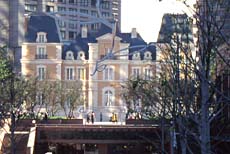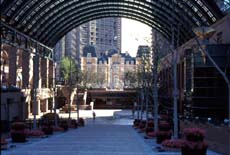index
The Chateau
click on images for full-size:




The Chateau at Ebisu Garden Place, Tokyo

Folly at Ebisu Garden Place

The Chateau seen through the mall
I've used my slides of the Chateau at Ebisu Garden Place to stimulate class discussion about context. The Chateau bothers students. Yet they don't balk at seeing modern International Style office buildings in Tokyo, perhaps because that style is not felt to be the property of any one group. They don't even mind the pomo classicism on some buildings at Ebisu, perhaps because it's so smoothed out that they don't read it as Western. The Chateau is not as large or irregular as a real chateau, but it looks like it might be on a postcard from France. It's as much a symbol as the folly they made out of the old brewery building, but it feels more real, and more out of place. My students laugh nervously and protest that the Chateau doesn't belong there. I remember my excitement when I first saw the Chateau -- I thought "this will be a sensational example for class discussion" but then I thought, "well, why not build a chateau there?" Given the ways architectural signifiers can be abstracted and moved around, what's so exceptional about Tokyo developers wanting to use a chateau-form to suggest luxury and quality? There's nothing theoretically surprising in the Chateau being there, and it doesn't bother the Japanese. Maybe the question should be reversed: Why, given the mobility of architectural forms, is there only one chateau in a prominent place in Tokyo? Is there an inertia even in the flighty mobility of signifiers? Is there tradition at work in supposedly anti-traditional cut-and-paste?